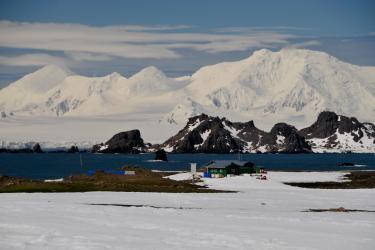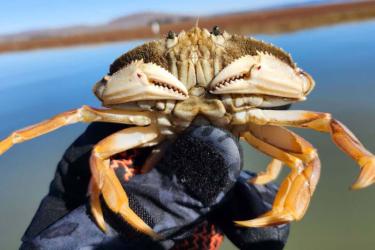One of the populations of killer whales that spends part of the year around the San Juan Islands north of Seattle is called the Southern Resident killer whales, and they're very endangered. There are only 81 of them left in the wild. That's the bad news. But the good news is that 81 is five more than there were last year. There was a baby boom among the Southern Residents recently, and for a population of this size, five new individuals is a very big deal.
In this video podcast we'll look at several amazing photographs that give us a glimpse not only of some of the new calves, but also of the family lives of these social animals. The photos were taken with an unmanned aerial vehicle, and to help us understand the photos we have one of the scientists who took them On the Line with us today.
John Durban is a marine mammal biologist with NOAA Fisheries, and he recently got back from the research expedition—a collaboration between NOAA Fisheries and the Vancouver Aquarium—that yielded these incredible pictures. Durban explains that these photos, in addition to being beautiful, are also full of data that help scientists monitor the health and reproductive success of this very endangered group of whales.
Scroll down to view and download the images.
Note: The researchers kept the UAV at least 90 feet above the whales at all times to avoid disturbing them. In addition, they were operating under research permits from NOAA Fisheries and flight authorization from the Federal Aviation Administration when in U.S. waters, and from Fisheries and Oceans Canada with flight authorization from Transport Canada when in Canadian waters.
![uav1.jpg]()
Dr. John Durban piloting the hexacopter into the hands of co-pilot Dr. Holly Fearnbach. The biologists, both with NOAA's Southwest Fisheries Science Center, are using the hexacopter to capture images of killer whales in order to assess their health. Credit: NOAA Fisheries.
![uav2.jpg]()
Overhead image of the newest member of the Southern Resident killer whale population, L122, just days after being born to first-time mother L91. This image shows the small size of neonate calves and the close bond between mother and calf that will last a lifetime. Credit: NOAA Fisheries, Vancouver Aquarium. Taken by UAV from above 90 feet under NMFS research permit and FAA flight authorization.
![uav3.jpg]()
New mother L91 eating a salmon as her newborn calf looks on. This fish was caught and given to her by other members of the family group, showing that relatives help her as she cares for her calf. Image to be used for health assessment. Credit: NOAA Fisheries, Vancouver Aquarium. Taken by UAV from above 90 feet under NMFS research permit and FAA flight authorization.
![uav4.jpg]()
An adult female Southern Resident killer whale (L94) nursing her calf. Lactation is energetically costly for these whales, and future photogrammetry images of the calf's growth and the mother's condition will reveal if the mother is getting enough food to support both herself and the calf. Note the distinctive saddle patch on the mother. This allows scientists to recognize individual whales in photographs. Credit: NOAA Fisheries, Vancouver Aquarium. Taken by UAV from above 90 feet under NMFS research permit and FAA flight authorization.
![uav5.jpg]()
A photogrammetry image of the entire I16 matriline of Northern Resident killer whales taken in 2014. This image shows the size of whales at different ages. Note the small, gray calf in the middle (I144), only a few months old, swimming to the right of its mother (I51). To the left of the mother is the calf's older sibling (I129). Images to be used for health assessment. Credit: NOAA Fisheries, Vancouver Aquarium. Taken by UAV from above 90 feet under Fisheries and Oceans Canada research permit and Transport Canada flight authorization.
![uav6.jpg]()
Another image of I51 and her two offspring, this one taken in 2015. Comparing this image to the one taken the year before, one can see that the youngest calf (I144) has lost its gray mottling and grown considerably. It is now almost half the length of its mother and approaching the length of its older sibling (I129). These images show how scientists can track the growth of individual whales across time to monitor their health and condition. Credit: NOAA Fisheries, Vancouver Aquarium. Taken by UAV from above 90 feet under Fisheries and Oceans Canada research permit and Transport Canada flight authorization.
![uav7.jpg]()
Photogrammetry image of an adult female Southern Resident (J16) as she's about to surface with her youngest calf, born earlier this year, alongside. Future photogrammetry will allow scientists to monitor the growth of the calf and condition of the mother to ensure they are getting an adequate food supply. Credit: NOAA Fisheries, Vancouver Aquarium. Taken by UAV from above 90 feet under NMFS research permit and FAA flight authorization.
![uav8.jpg]()
Photogrammetry image the A42 family group of Northern residents. Killer whales travel in their matrilineal family group their entire lives. Here the matriarch A42 is in the middle with her newest calf beneath her. Note A42's distinctive saddle patch. This allows scientists to recognize individual whales from the photographs and assess their health. Credit: NOAA Fisheries, Vancouver Aquarium. Taken by UAV from above 90 feet under Fisheries and Oceans Canada research permit and Transport Canada flight authorization.
![uav9.jpg]()
Photogrammetry image of an adult female Southern Resident killer whale (J28) traveling with her juvenile offspring (J46). This image reveals the wide body profile of the mother, indicating that she is likely pregnant and due to have a second calf in the coming months. Credit: NOAA Fisheries, Vancouver Aquarium. Taken by UAV from above 90 feet under NMFS research permit and FAA flight authorization.
![uav10.jpg]()
Photogrammetry image of an adult male Southern Resident killer whale (L41). This photo shows the tall dorsal fin, curved flukes, and large pectoral fins characteristic of adult males. Images to be used for health assessment. Credit: NOAA Fisheries, Vancouver Aquarium. Taken by UAV from above 90 feet under NMFS research permit and FAA flight authorization.
![uav11.jpg]()
Photogrammetry image of an adult male Southern Resident killer whale (K21). These images are being used to measure growth and body condition of whales that can be individually recognized from the distinctive pigmentation of their gray saddle patches, which allows scientists to monitor their health. Credit: NOAA Fisheries, Vancouver Aquarium.












